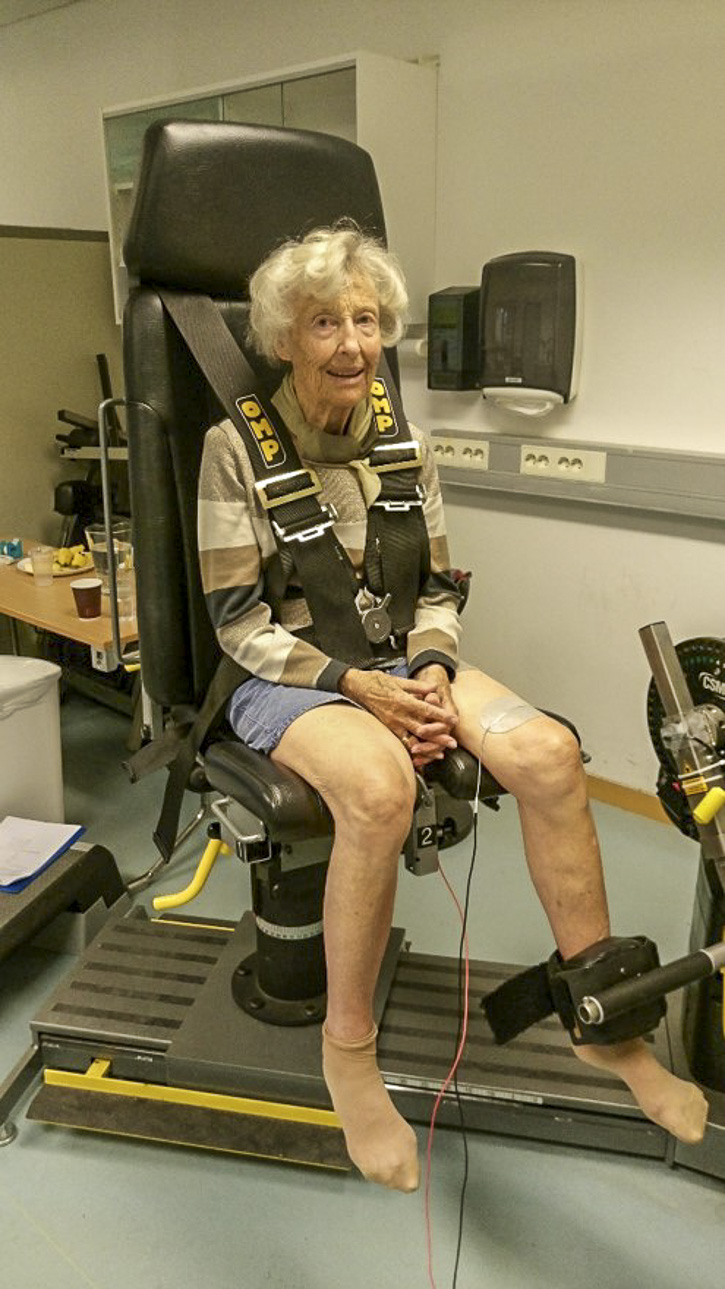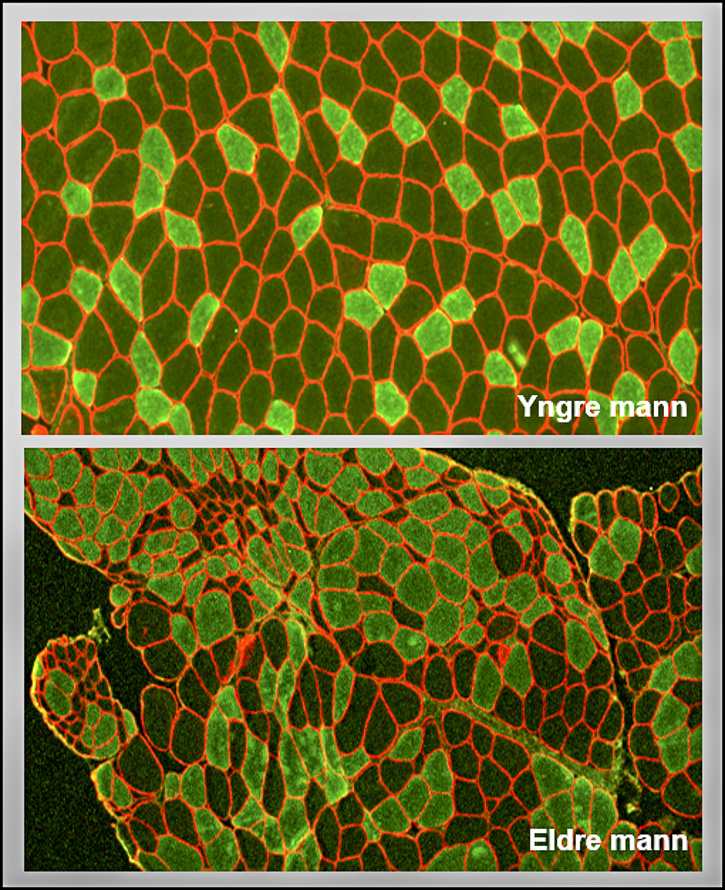He set out to study what happens when the very old start heavy weight training. His aim was also to study in detail why muscular strength deteriorates more than muscle mass as we get older.

Is it possible that the reduction in muscular quality is due to problems with the “waste management system” of muscle cells?
The results of his work on the doctoral thesis show that weight training is both effective and achievable if you want to remain independent when older. Sigve Nyvik Aas believes that weight training will provide greater health benefits for many older people when compared to fitness training, mobility training and balance training.
Deteriorates, but can be remedied
We all know the problem: The elderly have a tendency to “wither away”, they lose strength, become unsteady and are not able to move around like they used to. This is caused by a number of factors, including how the fast, explosive muscle fibres (“type II fibres”) in particular tend to shrink while there is less loss of the slower, endurance type I fibres.
This loss of the fast muscle fibres is critical, because you need explosive muscle power to get up from a chair and to quickly recover your balance if you are about to fall.
—The great thing is that this is something we can fix.
Best to use machines
Weight training using the machines in a gym provides numerous benefits. In contrast to going for a walk, heavy weight training will activate and strengthen the explosive type II fibres.
—It takes effort and heavy lifts, but even the very old can both achieve it and benefit from it greatly, says Sigve Nyvik Aas.
He is an advocate of using the machines in gyms, despite their somewhat poor reputation.

—You will hear a lot of people describing the machines in a gym as ‘not very functional’. In my opinion, they provide a number of benefits, particularly for older people who are a bit unsteady on their feet, he continues:
- With the machines, it’s easier to use heavier weights, achieving a good effect from the workout. There is no risk of falling and it is easier to use the correct technique.
- And even though the use of a seated leg press machine does not require balance, you achieve better balance with stronger muscles.
—I am therefore confident that the leg press machine, for example, can be extremely useful.
Development of muscle mass in the elderly
The average age of the participants in the first group studied was 85. They completed a 10-week-long weight training programme. They all lived at home and were healthy, and they attended a gym three times a week to carry out a 30-minute session.
They all grew stronger, with the average participant building almost three quarters of a kilo in new muscle mass in the legs. The improvements in muscle mass and strength also resulted in increased walking speed, perhaps due to improved balance.
The participants in the second study were not as healthy. Almost 50 percent of them lived in a nursing home and most needed a walker or walking aid to get around. The training sessions were tougher for these participants, and more than one in four dropped out. The dropout rate was related to motivation, a degree of pain during the training and other health problems.
Age no obstacle
However: When assessing all the participants who completed the study in total, the improvements seen in the latter “nursing home group” were almost just as good as in the first group, even though the latter group only worked out twice a week.
—One important observation is that there was absolutely no correlation between effect and age. The participants who were 90 years and older benefited just as much from the weight training as those who had just reached retirement, confirms Sigve Nyvik Aas.
—What the tests did demonstrate is that it’s easier to succeed if you start training while you are still reasonably healthy.
Deteriorating more than they should

Muscles will deteriorate in both the elderly and in persons who are not active. Anyone who has had a plaster cast on an arm or leg will have noticed how their muscles shrink.
However, it is not only the loss of muscle mass that causes the problem: The loss of strength in older people is greater than that implied by the loss of muscle mass. Why is this?
—One of the reasons is most likely the reduction in activation rate, the degree to which older people are able to activate the entire muscle, says Sigve Nyvik Aas. —Our test results show that older people who lift as much as they can with the front thigh muscle are able to activate around 85-90 percent of the muscle. In younger people, the activation rate is 95 percent.
It also seems that the quality of the actual muscle deteriorates.
—One of our hypotheses was that the systems designed to break down damaged muscle proteins become functionally impaired as you grow older. These systems perform 'waste management' for muscles, and there is evidence to show that disturbances in these systems will have a negative effect on muscle quality.
Studies of muscle biopsies
One of these breakdown systems is known as autophagy, and animal trials have shown that this process grows slower as an animal ages. Sigve Nyvik Aas decided therefore to check if this also occurred in humans.
This involved making a small incision in the skin on the thigh and removing a tiny piece of muscle, the size of a pea.
—We took muscle biopsies from the 85-year-old participants and compared these with muscle samples from persons aged 70 and 20. We discovered several differences both in autophagy and other breakdown systems. However, it’s still too early to conclude that autophagy is impaired with ageing, as we have seen in animals. We need to perform more analyses before we can make any claims.
Although muscle quality reduces with age, it is the actual loss of muscle mass that is the greatest problem for the elderly.
—A smaller muscle will almost always develop less strength than a larger muscle, says Sigve Nyvik Aas.
Rapid effect
One of the most positive lessons learned from the study is that weight training for older people has a positive effect in a very short time. A mere 10 weeks of weight training was enough to increase both muscle mass and walking speed.
—We actually noted that the participants in the control group, who did not receive training, had a minor reduction in walking speed over the 10-week period. This shows us how physical function is rapidly impaired in this age group, confirms Sigve Nyvik Aas, underlining the importance of measures to counter this.
—We have to provide proper training for so many more people in this age group, along with proper follow-up to make sure they are doing it right. The benefits in terms of both quality of life and reduced costs for society are vast if these people are able to live at home for longer, he says.
—Weight training provides so many health benefits that it should be on prescription.
- Sigve Nyvik Aas defended his doctoral thesis "Muscle protein degradation in elderly individuals" at the Norwegian School of Sport Sciences on 10 May 2019.
